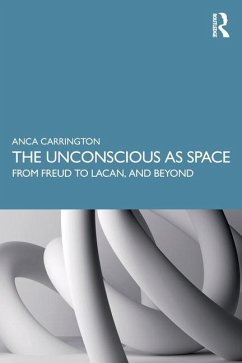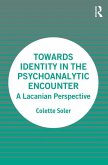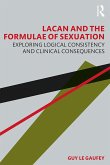The Unconscious as Space explores the experience of being and the practice of psychoanalysis by thinking of the unconscious in mathematical terms.
Anca Carrington introduces mathematical models of space, from dimension theory to algebraic topology and knot theory, and considers their immediate psychoanalytic relevance. The hypothesis that the unconscious is structured like a space marked by impossibility is then examined. Carrington considers the clinical implications, with particular focus on the interplay between language and the unconscious as related topological spaces in which movement takes place along knot-like pathways.
The Unconscious as Space will be of appeal to psychotherapists, psychoanalysts and mental health professionals in practice and in training.
Anca Carrington introduces mathematical models of space, from dimension theory to algebraic topology and knot theory, and considers their immediate psychoanalytic relevance. The hypothesis that the unconscious is structured like a space marked by impossibility is then examined. Carrington considers the clinical implications, with particular focus on the interplay between language and the unconscious as related topological spaces in which movement takes place along knot-like pathways.
The Unconscious as Space will be of appeal to psychotherapists, psychoanalysts and mental health professionals in practice and in training.
"Do you think you know everything about space? Even about the unconscious as space, and how it can be approached mathematically, topologically? Think again. This well-referenced book gives you food for thought, takes you by the hand to consider space anew - its dimensions, the importance of the hole, possible and impossible pathways, among other examples. This book does not just open your ears to new ideas but the space between them also." - Vincent Dachy, psychoanalyst in the Lacanian orientation
"The Unconscious as Space lucidly unfolds a compelling account of how thinking the Unconscious through mathematics, as space, affords those working with the unconscious, or the disjunctive fragments it presents us in conscious life, a coherent framing of why and how clinical interventions function. More than one thing can be true at the same time and this book has the maths to prove it! This readable book synthesises the arcane work of Lacan and other post-Freudians to date who attempted to think psychoanalysis through maths, making what might otherwise seem inaccessible and impossible both accessible and possible." - Christopher Simpson, Associate Lecturer, University of Northampton, UK
"Lacan explored mathematics through his use of the Phi and -phi as representing the imaginary and symbolic phallus. In addition, he used the square root of -1 and imaginary numbers to represent the Real. The Real is outside the signifier although topology is inside letters. Freud explored psychic space and concluded that space is an extension of the psyche, "the Unconscious is outside or in the environment, as Lacan said. Not too many have followed Lacan in his use of mathematics, this book is an exception. The book covers both familiar and unknown territory. From Freud's unconscious of the not yet known, to the unknowable, and to Lacan's L'insu qui sait or unknown knowing, to Bion's grid, and to Matte Blanco's symmetrical unconscious. The book points to the next step regarding psychic space as quantum phenomena, in terms of contemporary physics, rather than the physics of Freud's time." - Raul Moncayo, Ph.D. Senior Lacanian Analyst. Chinese American Center for Freudian and Lacanian Analysis and Research. Author Psychoanalysis and American Literature (Routledge)
"This book offers what can be seen as a form of conversation between parts of psychoanalysis and parts of mathematics. Written with great clarity, it is a lively and serious venture into a world that is usually restricted to specialists. The author explores a terrain that is fundamentally concerned with human suffering, and she tries to seek out the underlying spaces that she holds to be present in any engagement with it. Alain Connes - an eminence in mathematics - has recently entered into a dialogue with a psychoanalyst colleague in France. Anca Carrington's text is a step towards the possibility of such a dialogue in Britain: not only here, but in places yet further afield." - Bernard Burgoyne, Emeritus Professor of Psychoanalysis, Middlesex University
"The Unconscious as Space lucidly unfolds a compelling account of how thinking the Unconscious through mathematics, as space, affords those working with the unconscious, or the disjunctive fragments it presents us in conscious life, a coherent framing of why and how clinical interventions function. More than one thing can be true at the same time and this book has the maths to prove it! This readable book synthesises the arcane work of Lacan and other post-Freudians to date who attempted to think psychoanalysis through maths, making what might otherwise seem inaccessible and impossible both accessible and possible." - Christopher Simpson, Associate Lecturer, University of Northampton, UK
"Lacan explored mathematics through his use of the Phi and -phi as representing the imaginary and symbolic phallus. In addition, he used the square root of -1 and imaginary numbers to represent the Real. The Real is outside the signifier although topology is inside letters. Freud explored psychic space and concluded that space is an extension of the psyche, "the Unconscious is outside or in the environment, as Lacan said. Not too many have followed Lacan in his use of mathematics, this book is an exception. The book covers both familiar and unknown territory. From Freud's unconscious of the not yet known, to the unknowable, and to Lacan's L'insu qui sait or unknown knowing, to Bion's grid, and to Matte Blanco's symmetrical unconscious. The book points to the next step regarding psychic space as quantum phenomena, in terms of contemporary physics, rather than the physics of Freud's time." - Raul Moncayo, Ph.D. Senior Lacanian Analyst. Chinese American Center for Freudian and Lacanian Analysis and Research. Author Psychoanalysis and American Literature (Routledge)
"This book offers what can be seen as a form of conversation between parts of psychoanalysis and parts of mathematics. Written with great clarity, it is a lively and serious venture into a world that is usually restricted to specialists. The author explores a terrain that is fundamentally concerned with human suffering, and she tries to seek out the underlying spaces that she holds to be present in any engagement with it. Alain Connes - an eminence in mathematics - has recently entered into a dialogue with a psychoanalyst colleague in France. Anca Carrington's text is a step towards the possibility of such a dialogue in Britain: not only here, but in places yet further afield." - Bernard Burgoyne, Emeritus Professor of Psychoanalysis, Middlesex University








